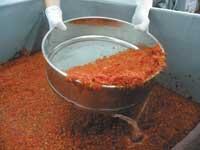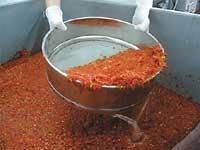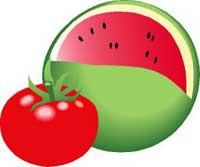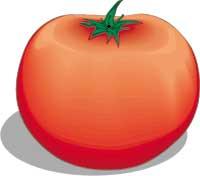Solid tomato waste in the food industry
2004/03/01 Atxotegi Alegria, Uhaina - Elhuyar Zientziaren Komunikazioa Iturria: Elhuyar aldizkaria

In Europe 8.5 million tons of tomato are produced. 1.5 million tons are sold directly to the consumer and 7 million tons are processed to make ketchup, sauces or other products. When the tomato is processed, 40% of the raw material is poured as waste, mainly bark and seeds. For the industry these residues are a fodder of animals or waste that must be deposited simply. But they are an excellent source of carotenes, proteins, sugars, fibers, waxes and oils that are of great interest for their content in unsaturated fats.
The objective of the TOM project is the recovery of these residues and the recovery of these components of high nutritional value. These are products that want to be used as additives in the food industry and that can have applications in pharmacy or cosmetics.
In fact, in the tomato is the carotene called likopene. This lycopene carries lipoproteins and is a forerunner of vitamin A. It is very beneficial for humans, among other things because it helps prevent degenerative diseases. In addition, the human body cannot produce by itself and needs. The consumption of tomato or its solid waste is therefore very healthy.

The recovery of these substances has other consequences: It will reduce by 30% the residues of the tomato processing industry.
New compounds
These purified compounds will also not have solvents used in other methods or pesticide residues. The method used to isolate components is the so-called affinity chromatography. The first raw extracts will be obtained by conventional and clean methods for the environment: water and supercritical CO 2. The extract will then be purified with affinity chromatography until it reaches 98% purity.
Affinity chromatography is a very powerful technique since it serves to extract any molecule. However, so far it has been applied in very specific areas due to the high cost of the technique, such as the pharmaceutical and cosmetic industry, for diagnostics or for pharmaceutical applications. In the TOM project they managed to apply this technique at an industrial scale and at a much lower cost.

Due to the low price of raw materials and the peculiarities of the process, a significant reduction in production costs is expected. Compared to other products of equal or inferior purity existing in the market, the new compounds will have a lower price.
Therefore, this project has sought to achieve two main elements: on the one hand, reduce the costs of the tomato processing industry and, on the other, minimize the environmental impacts of food additives derived from solid tomato waste.
www.ihobe.net
In May 2003 an international consortium was established for the implementation of this project (www.ttz bremerhaven.de/ /english/bilb/tom/descripton.html). In addition to the AZTI center, several companies and centers participate in this project: CATCHMABS BV of Holland, CAMPIL of Portugal, RIBERAL and CELIGUETA, S.A., Irish CYBERCOLORS Heidelberger Naturfarben GmbH and TTZ Bremerhaven and the National Institute of Chemistry of Slovenia, NIC. CAMPIL and RIBERAL are tomato processors; CATCHMABS BV, in addition to project coordinator, is the biotechnology company in charge of the development and applications of chromatography; CYBERCOLORS and Heidelberger Naturfarb, companies dedicated to the processing of natural foods, CELIGUETA, will be responsible for the correct use of food products and the evaluation of the results of Mbh. The TTZ, AZTI and NIC technology centres will be responsible for controlling the development of extracted and purified processes. They will also develop pilot applications, laboratory tests and analytical component analysis methods. |

Gai honi buruzko eduki gehiago
Elhuyarrek garatutako teknologia





